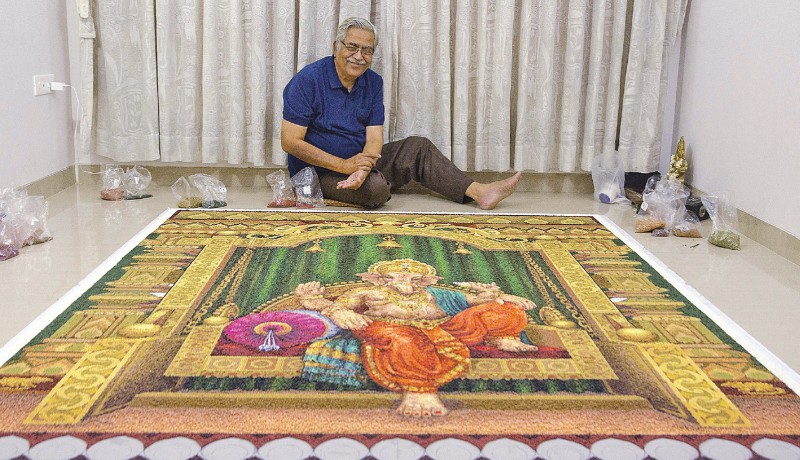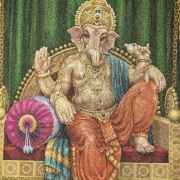
Etcetera

For 57 years, this Ganesha devotee has been making an unusual offering to the Elephant God: a sago rangoli that has also won him a Guinness record, finds Sahil Jaswal
Every year, a month before Mumbai brings her favourite idol home, Mohankumar Dodecha keeps his own date with a tradition. He spends 12 hours a day, every day, arranging pearl after pearl of sago or sabudana on the floor in a rangoli that eventually becomes a brilliant image of the Elephant God.
The Mumbai-based artist has, without exception, been creating and publicly displaying sago rangolis of Lord Ganesha for the past 57 years, a feat that earned him a mention in Guinness World Records for the longest duration over which an annual rangoli is displayed. This record, set in 2010, was with an 8 ft × 7 ft rangoli of Siddhivinayak Ganapati.
This year, for 10 days during Bhadrapad Ekadashi, from 1-10 September, thousands of visitors, including well-wishers and art lovers, flocked for darshan at the Prassan Mudra Ganesha at that the artist had created from over 40 kg of sago in 290 colours and shades. For the past three years, Dodecha has been creating his sago rangoli of Ganesha at a friends’ home as his own is under redevelopment.
Dodecha, who discovered his creative flair very early, honed this skill at the L S Raheja School of Arts, after which he specialised in interior design at the J J Institute of Applied Art, both in Mumbai. But he created his first sago rangoli well before his formal education in art and design began. “When I was in Class 10, one of my classmates told me of a Shivaji Maharaj rangoli he had seen in Dadar,” he shares. “It had been made entirely of coloured food grains. I was inspired by the idea. So, during Ganeshotsav that year, I asked my parents if I could explore a Ganesha rangoli made of grains. We lived in a one-room house and didn’t have much, and it was therefore crucial to ask my parents’ permission.”
Six days later, much to everyone’s amazement, a 4 ft × 5 ft rangoli occupied literally half the floor space of Dodecha’s one-room home. “My family and I shifted to the terrace for those six days,” he says, smiling at the recollection.
The first time Dodecha unveiled his sago rangoli to the public was in 1961. It was inaugurated by spiritual and social reformer Pandurang Shastri Athavale, popularly known as Dadaji. “He loved my rangoli and promised to unveil it every year. He did this for 25 years, and I considered his vow fulfilled. After that, my daughter-in-law has been inaugurating my sago Ganesha rangoli every year for the public,” reveals Dodecha, who earns a livelihood from the family’s octroirelated business.
He goes on to tell us how he discovered sago as a wonderful material for rangoli. “My first rangoli was made of different grains. The throne of Ganesha was supposed to be red and, with dhaniya seeds and other grains, I was unable to capture the vibrancy and flamboyance of the throne. That’s when I explored sago, which I coloured red. The colour was so vibrant and rich that it stood out majestically. Thereon, I started exploring different shades of colour on sago.” The rest, as they say, is rangoli history.
Dodecha designs are inspired by the mythological paintings of S M Pandit, who belonged to the school of realism and whose subjects ranged from events in the Ramayana, the Mahabharata and the Puranas. His other muse is Indra Sharma, an exponent of the Pichhwai style of painting.
For the first 40 years, he carefully and delicately recreated the paintings of S M Pandit and Indra Sharma on the floor of his house but in the last decade or so, he has taken the help of technology. Dodecha takes photocopies of parts of the paintings and pieces them together to complete the image. He then numbers different sections on the basis of the shade required, and starts filling up the sketch, one sago pearl at a time, with a tweezer!
Rangoli isn’t the only art form Dodecha enjoys. He also creates abstract Ganeshas in wood, metal, glass, thread, silver, paper, wool, beads, etc. And, although the Elephant God is his favourite subject, he has also made some pretty spectacular rangoli portraits of Mahatma Gandhi and Lal Bahadur Shashtri.
In 2010, Dodecha hosted an exhibition of his Ganesha sculptures at Mumbai’s Mulund Kalidas Natya Mandir. He also designs book covers for famous Gujarati poets such as Meghbindu, Kirit Barot and Barkatali Gulamhussain Virani. Asked to name his favourite sago rangoli, he says it was a 7 ft × 8 ft creation of Lord Ganesha, Kanva Rishi and Shakuntala based on the epic Abhigyanam Shakuntalam by Kalidasa. The rangoli, brought to life in over 350 shades of colour and made with 40 kg of sago, was crafted in 2009, a year before the artist celebrated a half-century of his sago rangoli.
Indeed, perseverance and patience have been the two cornerstones of Dodecha’s diligent tribute to Mumbai’s favourite deity. And, at the age of 73 now, he says, simply, “I will continue till I can.”
TREATING THE SAGO
Sago (sabudana) is a starch extracted from the spongy centre, or pith, of palm stems. It is produced commercially in the form of ‘pearls’, or small rounded starch beads, partly gelatinised by heating. When mixed with water, sago expands and starts dissipating in the liquid but Dodecha has evolved a technique to prevent that from happening. He sprinkles coloured water onto the sago and then rubs the coloured pearls in his hands. They expand to a certain extent and then shrink when dried in the sun after the colouring process. They shrink further when glue is applied.
Photos: Haresh Patel Featured in Harmony — Celebrate Age Magazine October 2017
you may also like to read
-
Cracking the longevity code
Small yet impactful choices can be game-changers, writes Srirekha Pillai At 102, there’s no stopping Chandigarh-based Man Kaur, the world’s….
-
Home, not alone
While a regulatory framework is vital for senior-care facilities, the need of the hour is to develop an ecosystem to….
-
Birthday Girl
Published in a special edition to honour Japanese master storyteller Haruki Murakami’s 70th birthday, Birthday Girl (Penguin; Rs 100; 42….
-
A huge treat for music lovers
Published as the revised and updated second edition, Incomparable Sachin Dev Burman (Blue Pencil; Rs. 599; 470 pages) the authoritative….








